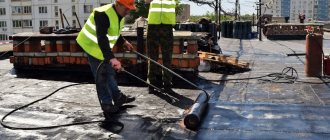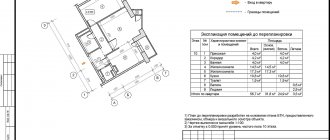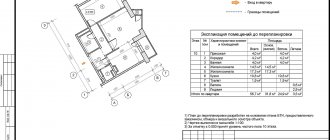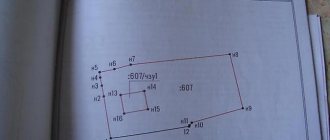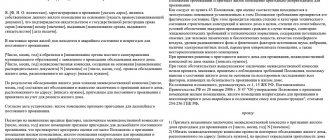What is considered a non-residential building?
To better understand the essence of the issue, you first need to decide what exactly is meant by non-residential premises. In general, identifying such buildings is quite simple: if they are not intended and are not used for human habitation, then they are non-residential. However, there is a more precise wording in the legislation.
To generalize, any building or premises in which people do not live and should not live is considered non-residential. These can be either entire industrial factory complexes or small sheds. This also includes basements and shops on the first floors of houses. By the way, any premises that were previously residential, and then were transferred to non-residential stock, are also considered non-residential.
Modern, new residential buildings usually already provide this feature. The entire first floor is automatically classified as non-residential and is initially intended to accommodate all kinds of retail outlets, cafes, and so on.
Where to go to have a building declared unsafe?
The local administration of any locality independently compiles a list of objects that need inspection. If a non-residential building that needs to be recognized as unsafe is included in this list, then there is no need to apply anywhere; the administration, represented by an interdepartmental commission, will independently conduct an inspection and notify the owner of its results.
If the building is not on the specified list, then you can write an application to the local administration requesting an inspection. There is no need to look for special organizations or take any additional actions - one application is enough. If there is no reaction to it, you can immediately go to court and demand a forced inspection.
Procedure
- The owner of the property sends an application to the local administration with a request to inspect the non-residential building to determine whether it is unsafe.
- The administration reviews the application and forms an interdepartmental commission.
- The commission (which includes, with an advisory vote, the owner of the non-residential building) hires specialists who will inspect the premises.
- Experts inspect the structure and write a report on the inspection results.
- Based on the report, the commission decides whether to consider the building unsafe (subject to demolition) or not. The decision is made by a majority vote. If the votes are equally divided, then the final decision is made by the head of the commission.
- After the decision is made, the owner is notified about this (given the fact that the owner is one of the members of the commission - this is more of a formality than a necessity).
- The commission's decision is sent to the local administration (which, given the presence of administration representatives on the commission, can also be considered a formality).
- The administration is studying the commission’s decision and, based on it, is already preparing an appropriate resolution to recognize the house as unsafe. The owner is notified of this again.
- Depending on the final decision, specific actions are assigned: restoration of real estate, demolition, reconstruction, and so on. Everything further happens in close cooperation between the administration and the property owner.
The procedure for recognizing a non-residential building as unsafe
The procedure for recognizing a non-residential building as unsafe is regulated primarily by the above-mentioned Resolution of the Government of the Russian Federation. However, even there there is no clear description of the actions of the experts who will inspect the home.
In this case, everything may depend on what kind of specialists the administration attracts for inspection and what internal rules apply in a particular region. Below we will consider an average version of how a building is recognized as unsafe.
Procedure
- The owner of the property sends an application to the local administration with a request to inspect the non-residential building to determine whether it is unsafe.
- The administration reviews the application and forms an interdepartmental commission.
- The commission (which includes, with an advisory vote, the owner of the non-residential building) hires specialists who will inspect the premises.
- Experts inspect the structure and write a report on the inspection results.
- Based on the report, the commission decides whether to consider the building unsafe (subject to demolition) or not. The decision is made by a majority vote. If the votes are equally divided, then the final decision is made by the head of the commission.
- After the decision is made, the owner is notified about this (given the fact that the owner is one of the members of the commission - this is more of a formality than a necessity).
- The commission's decision is sent to the local administration (which, given the presence of administration representatives on the commission, can also be considered a formality).
- The administration is studying the commission’s decision and, based on it, is already preparing an appropriate resolution to recognize the house as unsafe. The owner is notified of this again.
- Depending on the final decision, specific actions are assigned: restoration of real estate, demolition, reconstruction, and so on. Everything further happens in close cooperation between the administration and the property owner.
This is important to know: Do I need to pay for major repairs on the receipt, is it legal?
Documentation
There is no specific list of documents that the homeowner must provide. It all depends on the situation and the requirements of the administration. An example list might look like this:
- Certificate of ownership and/or extract from the Unified State Register of Real Estate.
- Passport of the applicant-owner.
- Technical passport for the building.
- Evidence that the non-residential premises/building is truly unsafe.
Deadlines
After receiving an application from the property owner, the local administration reviews it within about a month. Further:
- Notification of interested parties about the beginning of the formation of the commission: up to 10 days.
- Drawing up a specific list of commission members: up to 7 days.
- Approval of the composition of the commission: up to 7 days.
- Approval of the committee chairman: up to 10 days.
- Inspection of the object and generation of a report: individually. Rarely more than 1 month, more often – up to 1 week.
- Making a decision by the commission and notifying the property owner: up to 5 days.
- Making a final decision by the local administration based on the decision of the commission: up to 30 days.
FREE CONSULTATIONS are available for you! If you want to solve exactly your problem, then
:
- describe your situation to a lawyer in an online chat;
- write a question in the form below;
What documents does the owner need to collect: basic package
In order for the procedure for recognition of non-residential premises to start, you need to submit an application to the commission along with the following documents:
- passport - copy;
- title and registration documents for the apartment - copies;
- technical passport - you need to request it from the BTI if you don’t have it on hand. A copy is submitted, but you must have the original with you;
- general plan diagram of non-residential premises - this is also issued by the BTI;
- a copy of reports on repairs carried out in the building over the past three years;
- conclusion of the sanitary and epidemiological station and fire inspection on the unsafety of housing - originals.
Additionally, the owner can order an assessment of the technical condition of the building from experts, and attach a copy of the assessment to the package of documents. This way the matter can be resolved faster.
The municipality may ask for additional documents, so it's best to check what they need before applying.
Resolving issues where one party is a private person, and the other is a government representative, is difficult, because the latter often take advantage of the legal ignorance of the former, and do everything in a way that is beneficial to them, and not to the former owner of the building. So it is better to resolve such issues with a lawyer, and you can get a free consultation on our website.
How to recognize a non-residential building as unsafe
Walking around the city, we come across cafes, hairdressers, auto repair shops, shopping centers and other commercial facilities. Some are in new buildings, while others are in disrepair. Non-residential buildings declared unsuitable are included in the emergency real estate. Subsequently, they are subject to dismantling work (demolition).
Questions arise: what are the signs to determine whether a non-residential property is in danger of being damaged? Is the procedure different from declaring residential buildings unfit? What is the right for the owners of such buildings? We described the features of the procedure in our article.
What is a non-residential building?
The definition follows directly from the name.
Non-residential objects are divided into several types in accordance with clause 2 of Art. 2 Federal Law No. 384 “Technical Regulations...” dated December 30, 2009. Legislatively it is possible to designate:
- A building is a real estate object in the form of a capital (solid) structure with a delimited space inside. Moreover, it can contain both residential and non-residential premises, for example, office premises.
- A room is a separate, isolated part of a building with its own purpose. Such premises can be located in a residential building, for example, a hairdresser on the ground floor of a high-rise building.
- A structure is a system object that consists of load-bearing and enclosing structures similar to a residential building. However, structures are considered non-residential buildings, for example, a factory complex for the production of concrete blocks.
As we noted, the building is a solid structure. Non-residential properties can also be located in an apartment building. Usually the first floors or “zero” (ground) floor are used. Moreover, several commercial organizations can operate in the house. Their owners either rent objects or buy apartments and transfer them to non-residential premises.
The classification of commercial premises is very diverse: offices, retail outlets, universal, warehouse, workshop (production), etc.
Example 1:
IP Alekseev won the auction for the purchase of land for construction. The entrepreneur agreed with the contractor to begin construction of the retail outlet. The completed object will be considered a building. The purpose of the exploitation will be to make a profit - IP Alekseev provided cosmetology services.
Example 2:
Individual entrepreneur Sergeeva was looking for a place to equip a women's hairdressing salon. Soon she liked one option with non-residential premises. The landlord rented out an office on the first floor of an apartment building (MKD). The total area fit into 2 residential apartments, which were purchased and converted into non-residential space. Individual entrepreneur Sergeeva contacted the landlord and entered into an office rental agreement. From now on, she owned the non-residential part of the apartment building on the first floor.
Signs of an accident
When talking about accidents, we mean a significant violation of the technical elements of the building. Damage, deformation, risk of collapse, problems with communications - all these are signs of the unsuitable condition of a non-residential structure.
The features of identifying and recognizing the emergency status of commercial buildings are prescribed in the regulatory framework, namely clause 21, part III of the Decree of the Government of the Russian Federation No. 577 of May 17, 2021. The provisions affect non-residential and residential properties, with the exception of apartment buildings.
Signs of trouble include:
- Damage or deformation of load-bearing and enclosing elements of a non-residential building , for example - partial collapse of walls, malfunction of engineering components, sewerage, ventilation, heat and electricity supplies.
- Fire, accident, domestic explosion and other disruption in the operation of the facility . Restoring such a building is either physically impossible or requires significant financial costs. Most often, a decision is made to demolish an emergency facility and build a new structure in its place.
For example, a fire in the upper tier of a school building. The classrooms on the top floor were completely burned out, and part of the assembly hall and technical rooms were affected. The building is unsuitable for conducting lessons. Local authorities and the education department make a decision on the demolition of an emergency facility. A budget is allocated for the construction of a new school.
- Location in a zone of natural disasters or man-made accident . If there is no way to protect the building, it enters the emergency risk zone. Even if people do not live in it, the object is subject to dismantling (demolition).
This is important to know: Who should repair a balcony in a privatized apartment, change meters, batteries, pipes
The procedure for recognizing a non-residential building as unsafe
General control over the emergency and dilapidated housing stock in Russia is carried out by the federal authorities. Regions are subordinate to the center, but operate according to internal regulations. Each subject of the Russian Federation maintains a register of unsafe buildings, which includes not only residential but also non-residential buildings. There are no particular differences in the signs of accidents. But there is a difference in the procedure for declaring it unfit for use.
Where to begin?
Real estate objects are subject to monitoring and inspection by the authorities. Commissions monitor the condition of buildings, assess the level of damage and their danger to people. Therefore, if a non-residential building is already included in the “emergency” list, it will be checked as part of the priority list.
If the property is not listed in any address register, the owner will have to submit an application. Thus, he initiates an extraordinary check. This will help the authorities declare another non-residential structure unfit.
Step-by-step instruction
An action plan for recognizing a non-residential building as unsafe may include the following steps:
- Submitting an application to the department of urban services or housing policy (depending on the region).
- Consideration of the application within the established period of 30 days.
- Convening an interdepartmental commission from among specialists from the Ministry of Emergency Situations, the Sanitary and Epidemiological Station, Housing Supervision + interested property owners.
- Concluding a municipal contract with experts in the field of technical inspection of premises.
- Inspection of a non-residential building, generation of reports and recommendations.
- Voting of the commission members, counting of votes and drawing up the final decision - should the building be recognized as unsafe or not?
- Notifying the local administration, sending copies of documents.
- Discussion of the results of the commission’s work, creation of a resolution on recognition/non-recognition of the house as unsafe.
- Distribution of notices to the owners of non-residential properties.
- A set of measures based on the decision made - closure of the organization, change of legal address, preparation for demolition or renovation, etc.
The legislation determines that instead of housing rights, the owner of an emergency non-residential building is entitled to compensation . It is expressed in monetary terms. The amount of compensation should include not only the market value of the property, but also the losses of the owner. It is also possible to agree on the provision of an equivalent non-residential building/premises, for example, in one of the residential buildings in the area.
Final decision of the commission
Through joint efforts, the commission decides whether to consider a non-residential building unsafe and subject to demolition? The final verdict is made on the basis of the documents provided by the owner (registration certificate and inspection reports for previous years).
Conclusions about the condition of the property:
- the absolute suitability of a non-residential building or a house with a ground floor for offices - in this case the commission recognizes the reasons for the application as insignificant;
- the need for major repairs or reconstruction ;
- unsuitability of a non-residential building or premises - provides for the physical demolition of the object (clause 13, part II of PP No. 577 of May 17, 2017).
The catch is that members of the interdepartmental commission often act in the interests of city authorities. The decision of the experts inspecting the house may also be to the benefit of the customer of the service - the municipality. One of the most common violations is issuing an opinion without inspecting the property.
Experts may recognize a completely normal non-residential building as unsafe, or they may, on the contrary, not recognize the unsafe condition of a dilapidated structure. In these cases, much is “tied” to the composition of the development of the built-up area. If the owner’s property is located on a territory that the authorities like, they will do everything to buy his land at a low price. Recognizing a non-residential building as unsafe is one of the tricks to achieve what you want. The decision of the city authorities will have to be challenged in court.
Required documents
To start an accident check, you need to provide the commission with the following documents:
- a written statement - that the owner wishes to initiate an inspection of a non-residential building for damage;
- applicant's passport;
- documents of a legal nature - we are talking about title and registration papers (for example, a purchase and sale agreement or privatization of non-residential premises);
- a copy of the building's technical passport - issued at the BTI department;
- general plans and diagrams of non-residential premises in the building;
- copies of inspection, repair, and restoration reports of the facility for the last 3 years;
- conclusions of the SES and the Ministry of Emergency Situations of the Fire Supervision - on the condition of the building;
- other documents.
You may also need opinions on the technical condition of a non-residential property from licensed experts. If they reflect that the facility is in emergency status, the information will help quickly confirm this fact at the municipal level.
How is non-residential premises recognized as unsafe?
In order for a building to be recognized as unsafe, the owner needs to collect a package of documents, submit them to the municipality (the department that regulates housing issues in the city), and wait for the commission’s decision.
In practice, everything happens like this:
- an application and documents are submitted;
- they are reviewed by a commission within a month; if the building threatens others, then a decision must be made on it within 1-2 days;
- the commission makes a verdict - whether it should be demolished or not;
- if a decision is made to demolish, a resolution is issued, the owner receives compensation and transfers ownership to the municipality;
- If the owner does not agree with the amount, then the matter is resolved in court. But the building will still be demolished, just a little later - after the legal debate is over, or immediately if it is unsafe for others.
An important point for legal entities that are the owners of such buildings: at the final stage, when there is a decision to demolish the building, it is necessary to carry out the procedure of changing the legal address of the company.
Dear readers! We cover standard methods for solving legal problems, but your case may be unique. We will help you find a solution to your problem for free
— simply call our legal consultant at:
+7 (495) 128-73-40 (Moscow)
+7 (812) 603-71-55 (Saint Petersburg)
8 (800) 302-33-75 (free call within Russia)
It's fast and free ! You can also quickly get an answer through the consultant form on the website.
What might the commission's decision be?
Based on the results of a technical inspection of a dangerous building, the commission can make one of the following decisions:
- absolute suitability of the building - in this case, the reason for the owner’s appeal is considered insignificant, no one will demolish anything;
- the need to carry out reconstruction or major repairs - the building may be recognized as unsafe, but not subject to demolition;
- complete unsuitability of a non-residential premises or building - in this case it is subject to immediate demolition or such work can be carried out as planned (if the building does not pose a danger to others, bricks do not fall on heads).
The commission's decision is not always justified and corresponds to reality. In fact, the building may be in disrepair and repairs will not help it, but in order not to deal with its demolition and resolution of related issues, the municipality may recognize it as simply requiring major repairs. Such a decision can be appealed in court.
What will the owner of a non-residential building receive in return?
Events can unfold in different ways.
For example , in judicial practice there are disputes when the administration did not offer anything in return for a demolished property. The entrepreneur went to court, where he was denied. Then he complained to the Supreme Court of the Russian Federation, which sided with him - the court ordered local authorities to be guided by the regulatory framework of Art. 239.2 Civil Code of the Russian Federation, Art. 56.3 of the Land Code of the Russian Federation, as well as clause 10 of Art. 32 Housing Code of the Russian Federation. In other words, provide the plaintiff with proportionate compensation taking into account lost profits.
If the authorities offer an apartment or other residential premises, their decision is illegal. An object similar to the one being demolished - a non-residential building or premises in an apartment building - is subject to compensation.
What should the owner do:
- First, invite an appraiser and draw up a report on the market value of a non-residential structure (school building, cafe, retail outlet, warehouse).
- Secondly, send a valuable letter with acknowledgment of delivery to the local administration (executive committee of the city or district). Inform that you require reimbursement of the cost or provision of equivalent non-residential premises (see “Relocation from emergency housing”).
- Thirdly, wait for a response from the administration. If there is no response within 1 month or a refusal is received, contact the prosecutor’s office for a legal assessment. You need to complain about the actions/inactions of the authorities, depending on your situation. If the prosecutor's office does not help, involve a lawyer and file a claim in court.
This is important to know: Claim for recognition of ownership of real estate
So, non-residential objects are recognized as emergency by analogy with residential ones. The differences are related to the redemption price. The owner has the right to receive money for the demolition of the building and land. Residential premises are not provided in place of non-residential premises.
- Due to frequent changes in legislation, information sometimes becomes outdated faster than we can update it on the website.
- All cases are very individual and depend on many factors. Basic information does not guarantee a solution to your specific problems.
That's why FREE expert consultants work for you around the clock!
- via the form (below), or via online chat
- Call the hotline:
About emergency facilities
As follows from Part 10 of Art. 32 of the Housing Code of the Russian Federation, if an apartment building is recognized as unsafe, property owners must take measures for demolition or repair. Otherwise, the land plot along with the unsafe building is confiscated for the needs of the municipality. To ensure that the rights of owners are not violated, Russian legislation provides for equivalent compensation.
The decision to purchase real estate is made by the authority that previously decided to seize the land for the needs of the municipality or the state. In this case, the city administration. It does not take into account on what basis the owners of the premises use the land.
Seizure of premises, residential and non-residential, located in a dilapidated building, is carried out through redemption. Part 6 art. 32 of the Housing Code of the Russian Federation states that the conditions for compensation for seizure, the terms are prescribed in the agreement with the owners of the property. Mandatory conditions for compensation - payments must be made in advance of seizure, the amount must be equivalent to the value of the property.
Part 1 art. 36 of the RF Housing Code establishes that the land on which an apartment building stands is in the common possession of all homeowners.
From paragraph 2 of Art. 235, art. 239 of the Civil Code of the Russian Federation it follows that forced redemption from the owner of real estate is not allowed. However, there are exceptions to the rule. Property is confiscated if it is located on the plot being purchased. Consequently, in this case the need for seizure is natural and appropriate. On this basis, the judicial authority decided to satisfy the administration's claim.

